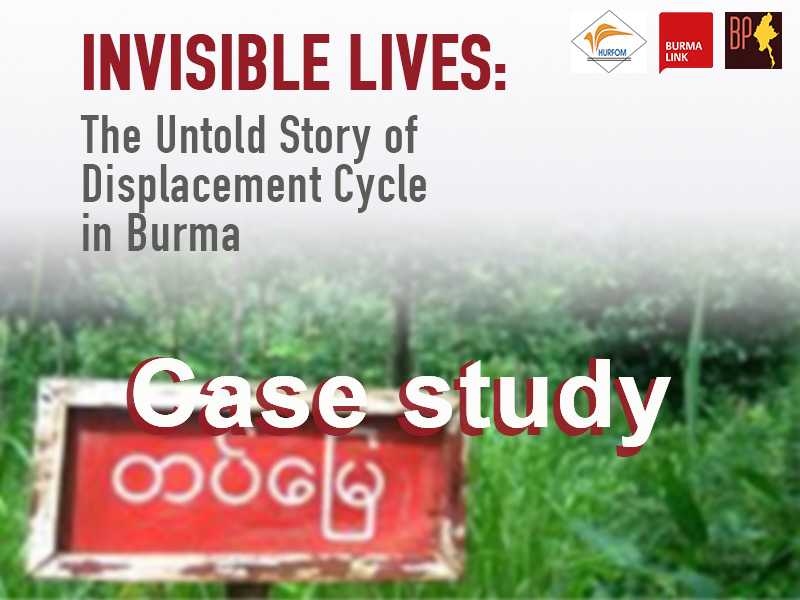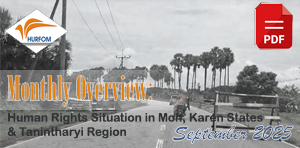Caught in the Middle – Land Confiscation by the Navy and Extortion by Splinter Groups: Mon IDP Report Case Study #5
October 5, 2016
 The following case study is from the joint report “Invisible Lives: The Untold Story of Displacement Cycle in Burma” by Human Rights Foundation of Monland (HURFOM), Burma Link, and Burma Partnership, which was launched in a press conference in Rangoon on August 12th and in Moulmein on August 15th. The 65-page report focuses on the continuing concerns of the displaced ethnic nationality communities, particularly the ethnic Mon, living along Burma’s southeast border and finds that the recent reforms have not yet addressed the causes of their displacement.
The following case study is from the joint report “Invisible Lives: The Untold Story of Displacement Cycle in Burma” by Human Rights Foundation of Monland (HURFOM), Burma Link, and Burma Partnership, which was launched in a press conference in Rangoon on August 12th and in Moulmein on August 15th. The 65-page report focuses on the continuing concerns of the displaced ethnic nationality communities, particularly the ethnic Mon, living along Burma’s southeast border and finds that the recent reforms have not yet addressed the causes of their displacement.
Download the full report (PDF) in English
Download the full report (PDF) in Burmese
The following is the fifth case study in a series that HURFOM, Burma Link and Burma Partnership have been publishing in the recent weeks along with a series of selected interviews. The series is meant to give more in depth understanding into the situation of Mon IDPs and villagers. See methodology in the report.
————————————————————————————————————
Caught in the Middle: Land Confiscation by the Navy and Extortion by Splinter Groups, Yebyu Township1: Case Study #5
“I have my properties there, so I have to die there. If I leave the village, what could I eat? I have a farm and plantation in the village. I have to live there till I die.”
(Nai Win)
For 30 years, Nai Win2 a 55-year-old farmer who lives in a village north of Yebyu Township has been growing rubber plants and betel nut trees on a plantation. The land “was my grandfather’s land. They worked on the land before I was even born. In the plantation, I grew 6,000 rubber trees and 5,000 betel nut trees,” as he recalls that the land has been in his family for almost 100 years. In 2011, a group of Burma Army soldiers, security guards and clerks from the land survey office (who measure land) came to him and took him to show him red signs that read “cantonment” on his land.
He has been told that the Navy will seize the land in the future. While him and his fellow villagers continue to live and cultivate on the land, they do not own a Land Use Certificate. He is at risk of losing his land and being evicted as the land ultimately belongs to the State under the 2008 Constitution. “If I didn’t do farming and plantation, I could do nothing […] I want to support my children to be educated with what I got from my plantation. Now only the youngest one is left to finish the school,” he stated.
Exacerbating his concerns are the continuing harassment by the splinter groups that operate in the area. In full uniforms and armed, various groups come to his village every year and extort the villagers by kidnapping family members, physically beating or threatening their lives to collect food, money and gold from the villagers. In August 2015, a splinter group, Mon Chan group, extorted seven million kyat (5,800 USD) from Nai Win’s village while taking 20 villagers hostage for an entire day. In these cases, the whole village typically has to cover the cost of the extortion. This has also devastated Nai Win’s village, putting him and other villagers in severe debt and poverty.
Nai Win has been kidnapped three times and taken to the jungle while his wife and villagers had to pay large sums to have him returned in safety. Several different splinter groups such as the Mon Chan, Chan Dain and Nai Loon groups, extort the villagers throughout the year, which means Nai Win has to take loans from others to pay for the high rate of extortion. He has not been able to pay back his debt. Other villagers “couldn’t afford to pay anymore, they left the village,” he said. Approximately 10 households have left the village because they were unable to pay the high price of extortion.
Although LIBs 273 and 282 from Yebyu Township have been contacted every time the splinter groups arrive as the NMSP are not allowed in the area, the Burma Army have continuously failed to respond or address these security concerns by the villagers.
- Mon villager, FGD and interview with author, Ye, 5 April 2016.
- Name has been changed to protect the identity of the individual.
Comments
Got something to say?
You must be logged in to post a comment.



















































